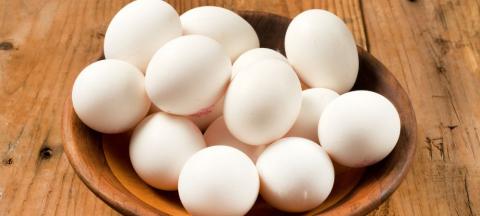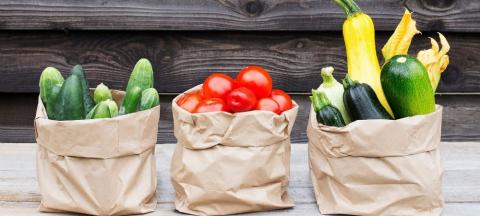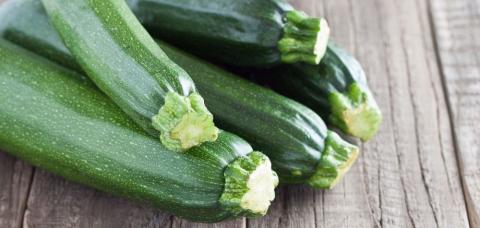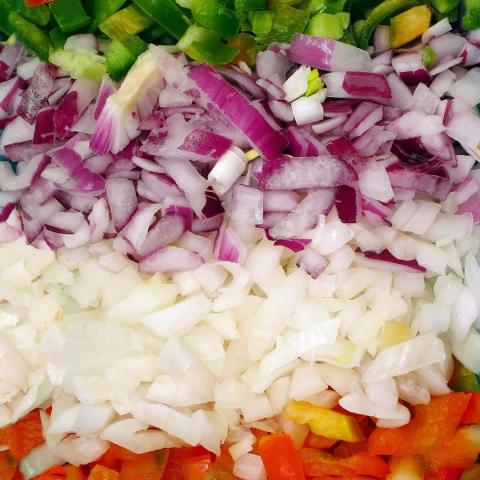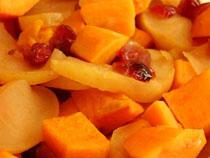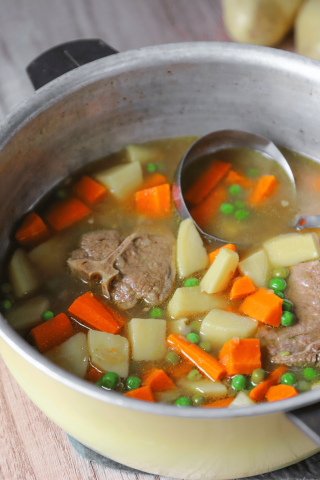
Jams, jellies, and preserves are foods with many textures, flavors, and colors. They consist of fruits preserved mostly by means of sugar and thickened or jellied to some extent. Here are the different types of jellied products:
- Jam is made from crushed or chopped fruits and sugar. Jam will hold its shape, but it is less firm than jelly. Jams made from a mixture of fruits are usually called conserves, especially when they include citrus fruits, nuts, raisins, or coconut.
- Jelly is a semisolid mixture of fruit juice and sugar that is clear and firm enough to hold its shape.
- Preserves are made of small, whole fruits or uniform size pieces of fruits in a clear, thick, slightly jellied syrup.
- Marmalades are soft fruit jellies with small pieces of fruit or citrus peel evenly suspended in a transparent jelly.
- Fruit butters are made from fruit pulp cooked with sugar until thickened to a spreadable consistency.
Ingredients in Jellied Products
For an acceptable jam or jelly, the proper amounts of acid (in the form of fruit or lemon juice), pectin, and sugar are necessary.
- Acid/Fruit: The fruit gives each spread its unique flavor and color. It also supplies the liquid to dissolve the rest of the necessary ingredients and furnishes some or all of the pectin and acid. High quality, flavorful fruits make the best jellied products. The proper level of acidity is critical to gel formation. If there is too little acid, the gel will never set; if there is too much acid, the gel will lose liquid (weep). For fruits low in acid, add lemon juice or other acid ingredients as directed. Commercial pectin products contain acids that help to ensure gelling.
- Pectin: Jams, jellies, and preserves get their smooth, semisolid consistency from pectin. Commercial pectin is extracted from apple cores or the white layer of citrus fruit. Commercial pectins contain added acid to ensure jelling. With commercially available pectin, various fruits, berries and other ingredients can be used to make a quality jam or jelly. Also, less cooking is necessary when pectin is added.
- Sugar: Sugar serves as a preserving agent, contributes flavor, and aids in gelling. Cane and beet sugar are the usual sources of sugar for jelly or jam. Corn syrup and honey may be used to replace part of the sugar in recipes, but too much will mask the fruit flavor and alter the gel structure. Use tested recipes for replacing sugar with honey and corn syrup. Do not try to reduce the amount of sugar in traditional recipes. Too little sugar prevents gelling and may allow yeasts and molds to grow.
Pectin and Thickeners for Jellies and Jams
Pectins are substances in fruits that form a gel if they are in the right combination with acid and sugar. All fruits contain some pectin. Apples, crabapples and gooseberries usually contain enough natural pectin to form a gel. Other fruits, such as strawberries and blueberries contain little pectin and must be combined with other fruits high in pectin or with commercial pectin products to obtain gels.
The following table lists the relative amount of pectin and acid for most fruits. Because fully ripened fruit has less pectin, one-fourth of the fruit should be underripe when making jellies without added pectin. Commercially frozen and canned juices may be low in natural pectins and make soft-textured jams and jellies.
| Group 1 - If not overripe, has enough natural pectin and acid for gel formation with only added sugar. | Group 2 - Low in natural acid or pectin and may need addition of either acid or pectin. | Group 3 - Always needs added acid, pectin or both. |
|---|---|---|
|
|
|
For successful products, use pectins as directed and do not exchange one type of pectin for another. Measure ingredients exactly to ensure a quality product. Prepare one batch at a time. Doubling a recipe may prevent proper jelling. Purchase fresh pectin each year. Old pectin may result in poor gels. Preservative may be included in commercial pectin to prevent microbial spoilage of the finished products.
Commercial Pectin: Pectins are grouped by type: regular or modified pectin. Be sure to follow the directions from the manufacturer. Modified pectins are available for home use to make reduced calorie jams and jellies. No-cook jams and jellies may be made with most pectins, both regular and modified pectins. No-cook preserves must be stored in the freezer until use. After opening, they can be stored in the refrigerator up to three weeks.
For successful products, use pectins as directed and do not exchange one type of pectin for another. Measure ingredients carefully. Prepare one batch at a time. Doubling a recipe may prevent proper jelling. Purchase fresh pectin each year. Old pectin may result in poor gels.
Gelatin: Gelatin, a protein substance derived from collagen, may be used as a thickener in refrigerator fruit spreads. Products made with gelatin must be refrigerated and used within one month. Unflavored gelatin does not contain pectin. Artificial sweeteners can be used with refrigerator jam and jelly recipes made with gelatin.
Thickener for Pie Fillings: ClearJel® is a modified cornstarch that produces excellent sauce consistency after pie fillings are canned and baked. ClearJel is not recommended for jams or jellies.
Preparation Methods
There are two basic methods of making jams and jellies.
- The standard method: Does not require added pectin and works best with fruits naturally high in pectin.
- Using commercial liquid or powdered pectin: This method is much quicker. The gelling ability of various pectins differs. To make uniformly gelled products, be sure to add the quantities of commercial pectins to specific fruits as instructed on each package. Overcooking may break down pectin and prevent proper gelling.
When using either method, make one batch at a time, according to the recipe. Increasing the quantities of the ingredients often results in soft gels. Stir constantly while cooking to prevent burning. Recipes are developed for specific jar sizes. If jellies are filled into larger jars, excessively soft products may result.
Processing
Even though sugar helps preserve jams and jellies, molds can grow on the surface of these products. Research shows that the mold which people usually scrape off the surface of jellies may not be as harmless as it seems. Mycotoxins have been found in some jars of jelly having surface mold growth. Mycotoxins are known to cause cancer in animals; their effects on humans are still being researched.
Because of possible mold contamination, paraffin or wax seals are no longer recommended for any sweet spread, including jellies. To prevent growth of molds and loss of good flavor or color, fill products hot into sterile Mason jars (canning jars), leaving ¼-inch headspace, seal with self-sealing lids and process 5 minutes in a boiling-water or steam canner (for altitudes of 0-1000 feet).

Correct process time at higher elevations by adding 1 additional minute per 1,000 feet above sea level. If non-sterile jars are used, the filled jars should be processed 10 minutes. Use of sterile jars is preferred, especially when fruits are low in pectin, since the added 5-minute process time may cause weaker gels. To sterilize empty jars, see Let’s Preserve: Canning Basics (EC434).
This map shows Nebraska elevations. You need to know your elevation to determine the correct processing time when canning. For those living outside of Nebraska, you can find your elevation at your local planning commission or zoning office, on a webpage or use an app.

Tests for Proper Gelling of Jellies and Jams
To test jelly for doneness, use one of the following methods.
- Temperature Test: Use a jelly or candy thermometer and boil until mixture reaches the following temperatures at altitudes of:
| Sea Level | 1,000 feet | 2,000 feet | 3,000 feet | 4,000 feet | 5,000 feet | 6,000 feet | 7,000 feet | 8,000 feet |
|---|---|---|---|---|---|---|---|---|
| 220°F | 218°F | 216°F | 214°F | 212°F | 211°F | 209°F | 207°F | 205°F |
- Sheet or Spoon Test: Dip a cool metal spoon into the boiling jelly mixture. Raise the spoon about 12 inches above the pan (out of steam). Turn the spoon so the liquid runs off the side. The jelly is done when the syrup forms two drops that flow together and sheet or hang off the edge of the spoon.

- Refrigerator/Freezer Test: Remove the jelly mixture from the heat. Pour a small amount of boiling jelly on a cold plate and put it in the freezing compartment of a refrigerator for a few minutes. If the mixture gels, it is ready to fill. When doing this test, remove the remaining jelly mixture from the heat.
To test jam for doneness, use the above temperature or refrigerator/freezer test.
Extracting Juice
- Use only firm fruits naturally high in pectin. Select a mixture of about ¾ ripe and
¼ underripe fruit. Do not use commercially canned or frozen fruit juices. Their pectin content is too low.
- Wash all fruits thoroughly before cooking. Crush soft fruits or berries; cut firmer fruits into small pieces. Using the peels and cores adds pectin to the juice during cooking.
- Add water to fruits that require it, as listed in Table 1. Put fruit and water in large saucepan and bring to a boil. Simmer according to the times in Table 1 until fruit is soft, while stirring to prevent scorching. One pound of fruit should yield at least 1 cup of clear juice.
- When fruit is tender, strain through a colander, then strain through a double layer of cheesecloth or a jelly bag. Allow juice to drip through, using a stand or colander to hold the bag. Pressing or squeezing the bag or cloth will cause cloudy jelly.
Making Jelly without Added Pectin
- Wash hands with soap and water. Using no more than 6 to 8 cups of extracted fruit juice at a time, measure fruit, juice, sugar, and lemon juice (according to the ingredients in Table 1) and heat to boiling.
- Stir until the sugar is dissolved. Boil over high heat to the jellying point. Use one of the gelling tests to determine when jellies are ready to fill in jars.
- Remove from heat and quickly skim off foam. Fill sterile jars with jelly. Use a measuring cup or ladle the jelly through a wide-mouthed funnel, leaving ¼-inch headspace.
- Wipe jar rims with dampened clean paper towel. Adjust lids and process. Recommended process times are provided in Table 2. Wait 5 minutes before removing jars from canner.
Making Jam without Added Pectin
- Wash hands with soap and water. Wash and rinse all fruits thoroughly before cooking. Do not soak. For best flavor, use fully ripe fruit.
- Remove stems, skins, and pits from fruit; cut into pieces and crush. For berries, remove stems and blossoms and crush. Seedy berries may be put through a sieve or food mill.
- Measure crushed fruit into large saucepan using the ingredient quantities specified in Table 3.
- Add sugar and bring to a boil while stirring rapidly and constantly. Continue to boil until mixture thickens. Use the temperature or refrigerator/freezer gelling test to determine when jams are ready to fill.
- Remove from heat and skim off foam quickly. Fill sterile jars with jam. Use a measuring cup or ladle the jam through a wide-mouthed funnel, leaving ¼-inch headspace. Wipe jar rims with a dampened clean paper towel. Adjust lids and process. Recommended process times are provided in Table 2. Wait 5 minutes before removing jars from canner.
Making Jams and Jellies with Added Pectin
Fresh fruit and juices, as well as commercially canned or frozen fruit juice, can be used with commercially prepared powdered or liquid pectins. The order of combining ingredients depends on the type of pectin used. Complete directions for a variety of fruits are provided with packaged pectin.
Jelly or jam made with added pectin requires less cooking and generally gives a larger yield. These products have more natural fruit flavors, too. In addition, using added pectin eliminates the need to test hot jellies and jams for proper gelling. Adding ½ teaspoon of butter or margarine with the juice and pectin will reduce foaming. However, these may cause off-flavor in long-term storage of jellies and jams.
Use pre-sterilized Mason canning jars, self-sealing, two-piece lids, and process in a boiling-water bath or steam canner according to Table 2. Wait 5 minutes before removing jars from canner.
Reduced Sugar Spreads
A variety of fruit products may be made that are tasteful, yet lower in sugars and calories than regular jams and jellies. Low-calorie jams and jellies cannot be made by leaving the sugar out of regular jam or jelly recipes. However, reduced sugar fruit products can be made using the following methods or products:
- Special Modified Pectins — These pectins have been modified to gel with reduced sugar or no sugar. The label will say “light,” “lite,” or “low or no sugar.” Some pectin products are made for recipes which call for less sugar and some for use with artificial sweetener. Recipes and processing times provided with each modified pectin product must be followed carefully. The proportions of acids and fruits should not be altered, as spoilage may result. Products made with modified fruit pectin must be processed longer to prevent spoilage.
- Regular Pectin with Special Recipes — These special recipes have been formulated so that no added sugar is needed. However, each package of commercial regular pectin does contain some sugar. Artificial sweetener is often added in the recipe.
- Recipes Using Gelatin — Some recipes use unflavored gelatin as the thickener for the jelly or jam. A low calorie sweetener is often added. Jams and jelly made with gelatin should not be processed. Such products spoil at room temperature, must be refrigerated, and should be eaten within 1 month.
- Long-Boil Methods — Boiling fruit pulp for extended periods of time will make a product thicken and resemble a jam, preserve, or fruit butter. Artificial sweetener may be added. For best results, add artificial sweetener after heating.
NOTE: The sweetener recommended in most of the recipes is liquid saccharin. One-eighth teaspoon of liquid saccharin equals the sweetening power of one teaspoon of sugar. If you use other sweeteners, read the label to determine their sweetening power.
Do not attempt to reduce the amount of sugar called for in traditional recipes. Reduction in the amount of sugar will interfere with gel formation and result in a product in which yeasts and molds can grow.
Remaking Instructions
It is best to recook only four to six cups of jelly or jam at one time.
Using Powdered Pectin
- 4 cups jelly or jam
- ¼ cup sugar
- ½ cup water
- 2 tablespoons bottled lemon juice
- 4 teaspoons powdered pectin
- Wash hands with soap and warm water.
- Measure the jam or jelly and sugar into a bowl.
- Mix the water, lemon juice, and pectin and bring to boiling, stirring constantly to prevent scorching. Add the jelly or jam and sugar. Stir thoroughly. Bring to a full rolling boil over high heat, stirring constantly. Boil mixture hard for 30 seconds.
- Remove jelly or jam from the heat, skim off foam, and pour into hot sterilized jars, leaving ¼-inch headspace. Wipe jar rims with a dampened clean paper towel. Adjust new lids and process according to original recipe.
Using Liquid Pectin
- 4 cups jelly or jam
- ¾ cup sugar
- 2 tablespoons bottled lemon juice
- 2 tablespoons liquid pectin
- Wash hands with soap and warm water.
- Bring the jelly or jam to boiling on high heat. Quickly add the sugar, lemon juice and pectin, and bring to a full rolling boil, stirring constantly. Boil mixture hard for 1 minute.
- Remove jelly or jam from the heat, skim off foam, and pour into hot sterilized jars, leaving ¼-inch headspace. Wipe jar rims with a dampened clean paper towel. Adjust new lids and process according to original recipe.
Cooked Jelly Without Adding Pectin
- 4 cups jelly
- 2 tablespoons bottled lemon juice
- Wash hands with soap and warm water.
- Heat jelly and lemon juice to boiling and boil for a few minutes. Use one of the gelling tests to determine just how long to cook it.
- Remove jelly from the heat, skim off foam, and pour into sterilized hot jars, leaving ¼-inch headspace. Wipe jar rims with a dampened clean paper towel. Adjust new lids and process according to original recipe.
Remake Instructions for Soft Freezer Jams or Jellies
Using Powdered Pectins (for trial)
- 1 cup jam or jelly
- 2 tablespoons sugar
- 1 tablespoon water
- 1 ½ teaspoons powdered pectin (stir before measuring)
- Wash hands with soap and warm water.
- Measure the jam or jelly and sugar into a bowl. Stir very well until sugar is dissolved.
- Measure water and powdered pectin into a very small saucepan. Stir over low heat until pectin is dissolved. Add this to sugar and fruit mixture. Stir until thoroughly blended — about 2-3 minutes.
- Ladle quickly into clean containers (leave extra headspace to allow for expansion of jam or jelly, if freezing). Cover at once with tight lids. Let stand in refrigerator until set (may take up to 24 hours). Then store in freezer. May be stored in refrigerator, for use within 3 weeks.
If trial is satisfactory, remake balance using above proportions. Do not remake more than 8 cups at one time.
Using Liquid Pectins (for trial)
- 1 cup jam or jelly
- 3 tablespoons sugar
- 1 ½ teaspoons lemon juice
- ½ tablespoon liquid pectin
- Wash hands with soap and warm water.
- Measure jam or jelly into bowl. Add sugar and lemon juice. Stir very well until sugar is dissolved (about 3 minutes).
- Add liquid pectin and stir until well blended (about 3 minutes).
- Ladle quickly into clean containers (leave extra headspace to allow for expansion of jam or jelly, if freezing). Cover at once with tight lids. Let stand in refrigerator until set (may take up to 24 hours). Then store in freezer. May be stored in refrigerator, for use within 3 weeks.
If trial is satisfactory, remake the balance using the above proportions. Do not remake more than 8 cups at one time.
Recipes
- Pear-Apple Jam
- Strawberry-Rhubarb Jelly
- Blueberry Spice Jam
- Grape Plum Jelly
- Chokecherry Syrup and Jelly
2 cups peeled, cored, and finely chopped pears (about 2 pounds)
1 cup peeled, cored, and finely chopped apples
6 ½ cups sugar
¼ teaspoon ground cinnamon
1/3 cup bottled lemon juice
6 ounces liquid pectin
Yield: About 7 to 8 half-pints
- Wash hands with soap and water. Crush apples and pears in a large saucepan and stir in cinnamon. Thoroughly mix sugar and lemon juice with fruits and bring to a boil over high heat, stirring constantly. Immediately stir in pectin. Bring to a full rolling boil and boil hard 1 minute, stirring constantly.
- Remove from heat, quickly skim off foam, and fill hot sterile jars leaving ¼-inch headspace. Wipe jar rims with a dampened clean paper towel. Adjust lids and process in a boiling water bath or steam canner according to Table 2. Wait 5 minutes before removing jars from canner.
1 ½ pounds red stalks of rhubarb
1 ½ quarts ripe strawberries
½ teaspoon butter or margarine to reduce foaming (optional)
6 cups sugar
6 ounces liquid pectin
Yield: About 7 half-pints
- Wash hands with soap and water. Wash and cut rhubarb into 1-inch pieces and blend or grind. Wash, stem, and crush strawberries, one layer at a time, in a saucepan. Place both fruits in a jelly bag or double layer of cheesecloth and gently squeeze out juice. Measure 3 ½ cups of juice into a large saucepan. Add butter and sugar, thoroughly mixing into juice. Bring to a boil over high heat, stirring constantly. Immediately stir in pectin. Bring to a full rolling boil and boil hard 1 minute, stirring constantly.
- Remove from heat, quickly skim off foam, and fill hot sterile jars leaving ¼-inch headspace. Wipe jar rims with a dampened clean paper towel. Adjust lids and process in a boiling water bath or steam canner according to Table 2. Wait 5 minutes before removing jars from canner.
2 ½ pints ripe blueberries
1 tablespoon lemon juice
½ teaspoon ground nutmeg or cinnamon
5 ½ cups sugar
¾ cup water
1 box (1 ¾ ounces) powdered pectin
Yield: About 5 half-pints
- Wash hands with soap and water. Wash and thoroughly crush blueberries, one layer at a time, in a saucepan. Add lemon juice, spice, and water. Stir in pectin and bring to a full rolling boil over high heat, stirring frequently. Add the sugar and return to a full rolling boil. Boil hard for 1 minute, stirring constantly.
- Remove from heat, quickly skim off foam, and fill hot sterile jars leaving ¼-inch headspace. Wipe jar rims with a dampened clean paper towel. Adjust lids and process in a boiling water bath or steam canner according to Table 2. Wait 5 minutes before removing jars from canner.
3 ½ pounds ripe plums
3 pounds ripe Concord grapes
1 cup water
½ teaspoon butter or margarine to reduce foaming (optional)
8 ½ cups sugar
1 box (1 ¾ ounces) powdered pectin
Yield: About 10 half-pints
- Wash hands with soap and water. Wash and pit plums; do not peel. Thoroughly crush the plums and grapes, one layer at a time, in a saucepan with water. Bring to a boil, cover, and simmer 10 minutes. Strain juice through a jelly bag or double layer of cheesecloth. Measure sugar and set aside. Combine 6 ½ cups of juice with butter and pectin in a large saucepan. Bring to a hard boil over high heat, stirring constantly. Add the sugar and return to a full rolling boil. Boil hard for 1 minute, stirring constantly.
- Remove from heat, quickly skim off foam, and fill hot sterile jars leaving ¼-inch headspace. Wipe jar rims with a dampened clean paper towel. Adjust lids and process in a boiling water bath or steam canner according to Table 2. Wait 5 minutes before removing jars from canner.
Chokecherry Syrup and Jelly Recipes
Extracting Fruit Juice
Extracting juice from the fruit is the first step in preparing a fruit syrup or fruit jelly. Use ripe fruit or berries for syrup or pectin-added jelly. If the juice is to be used for traditional or long-boil method jelly, use ¼ underripe and ¾ ripe fruit.
- Wash fruit, remove seeds then crush berries. The seeds of chokecherries contain a cyanide-forming compound which can cause illness or death if eaten in large amounts. Chokecherries give about 2 cups of juice per pound of fruit. Place pitted crushed fruit in a large, heavy kettle, add water to cover fruit, and place cover on the kettle. Bring mixture to a boil and simmer 15 minutes or until soft.
- Pour everything into a damp jelly bag and suspend the bag to drain the juice. For clearer jelly do not press or squeeze the bag. If the fruit juice is extracted through a fruit press, restrain the juice through a damp jelly bag.
Use the juice in the following recipes.
Chokecherry Syrup
4 cups chokecherry juice
4 cups sugar
½ cup lemon juice
½ package powdered pectin (3 tablespoon)
- Wash hands with soap and water. Extract chokecherry juice as directed. Mix and boil ingredients for 2 minutes in a large heavy kettle, stirring constantly. Fill hot, sterilized half-pint jars with hot liquid; leave ¼-inch headspace.
- Wipe jar rims with a dampened clean paper towel. Adjust lids and process in a boiling-water canner or steam canner following the processing times in Table 4. Wait 5 minutes before removing jars from canner.
Chokecherry Jelly
3 cups chokecherry juice
6 ½ cups sugar
3 ounces liquid pectin
¼ teaspoon almond extract (optional)
- Wash hands with soap and water. Extract chokecherry juice as directed. Pour juice into a large heavy kettle. Add sugar and stir to mix. Place over high heat. Bring to a boil, stirring constantly. Add pectin while stirring. Bring to a full, rolling boil and boil hard for 1 minute, stirring constantly.
- Remove from heat. Stir and skim for 5 minutes. Add almond extract, if desired. Pour into hot, sterilized half-pint jars; leave ¼-inch headspace. Wipe jar rims with a dampened clean paper towel. Adjust lids and process in a boiling water bath or steam canner according to Table 2. Wait 5 minutes before removing jars from canner.
Reference to commercial products or trade names is made with the understanding that no discrimination is intended of those not mentioned and no endorsement by University of Nebraska–Lincoln Extension is implied for those mentioned.
Sources:
Andress, E., and J. Harrison. So Easy to Preserve. 6th ed. Athens: University of Georgia Cooperative Extension Service, 2014.
Complete Guide to Home Canning, Agriculture Information Bulletin No. 539, 2015 revision, United States Department of Agriculture
How to Make Jelly, University of Minnesota Extension
How Do I? ... Jams and Jelly, National Center for Home Food Preservation
This publication was originally written by Julie Albrecht. It was reviewed and updated in 2020 by Carol Schwarz.
Feedback Form
Feedback Form
If you do not see the article, please scroll up the page.
